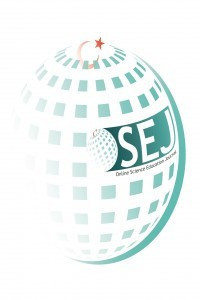Araştırma Makaleleri
Derleme Makaleler
Sayı Editör Kurulu




Amaç ve Kapsam
Online Science Education Journal, OSEJ, focuses on serving individuals, especially future generations, to acquire knowledge and skills, and adopts them as its vision. In this sense, OSEJ sees it as its mission to contribute to the development of science education activities in all levels and subject areas from pre-school to higher education and to serve all stakeholders.
OSEJ provides all kinds of scientific studies in all areas of science education.
It is obligatory that the manuscript to be submitted for publication has to be appropriate in accordance with the manuscript rules and publication conditions of our journal.
Research articles that discuss and analyze the topics from different perspectives, teaching application examples, and review studies are given priority. However, the book review that is thought to contribute to our journal's stakeholders in the field of science education, and studies on the introduction of education and didactic theories may also be published.
The evaluation process of the manuscripts sent to our journal starts and is completed electronically. The manuscript submitted by the author(s) is reviewed firstly by the editorial board in terms of appropriateness of content to the OSEJ. After this, the journal editor will appoint two reviewers with a doctorate degree. Once the two referees have issued a decision for publication as positively, the article has prepared in terms of the rules of writing and quotes of OSEJ and investigated the appropriateness of plagiarism and so on (this review process does not change the responsibility of the author).
Yazım Kuralları
Dergi yazı şablonunu indirmek için tıklayınız.
YAZIM KURALLARI ve YAYIN KOŞULLARI
Başlık ve Yazar Bilgileri
· Başlık: 14 punto, Times New Roman, kalın, her kelimenin sadece ilk harfi büyük harfle, ortalanmış olarak yazılmalıdır.
· Yazar İsimleri: 10 punto, Times New Roman, kalın, alt alta yazılmalıdır. Yazar isimlerinden sonra “,” konularak kurum bilgisi (italik) ve yine “,” konularak, e-posta adresi (italik) yazılmalıdır.
Özetler
· Özet: 10 punto, Times New Roman olmalıdır. “Abstract” kelimesi ilk harfi büyük, sola yaslı yazılmalıdır. Bu bölüm araştırmanın amacı, yöntemi, bulguları, sonuç ve önerilerini kapsayacak şekilde 100-250 kelime arasında olmalıdır. Abstract içerisinde kaynak verilmemelidir.
· Keywords: 10 punto, Times New Roman olmalıdır. Çalışmayı betimleyen 3-5 anahtar kelime olmalıdır.
Bölümler ve Alt Bölümler
Tüm metnin içeriği 12 punto, Times New Roman, tek satır aralıklı, iki yana yaslı yazılmalıdır. Paragraflar 1 tab girinti ile başlamalı, paragraflar arası boşluk içermemelidir. Ana bölüm başlıkları ortalı, 12 punto, kalın ve büyük harfle yazılmalıdır. Alt bölüm başlıkları (İkinci düzey başlıklar) sola yaslı, ilk harfleri büyük, 12 punto ve kalın olarak yazılmalıdır. Üçüncü düzey başlıklar ise sola yaslı, sadece ilk kelimenin ilk harfi büyük olacak biçimde, 12 punto, kalın ve italik yazılmalıdır. İngilizce özetin dil bilgisi hatası içermemesi için alanda uzmanı tarafından kontrolüne özen gösterilmelidir.
Makalenin bölümleri genel olarak şu başlıkları içermelidir:
GİRİŞ YÖNTEM Araştırmanın Modeli Çalışma Grubu Veri Toplama Araçları Verilerin Analizi BULGULAR TARTIŞMA, SONUÇ VE ÖNERİLER KAYNAKLAR EXTENDED ABSTRACT Purpose and Significance Methodology Results Discussion and Conclusion |
Tablo: Tablo ismi tablonun üstünde, sola dayalı olarak yazılmalıdır. “Tablo 1.” kalın olarak belirtilmeli, tablo adı ise italik yazılmalıdır. Tablo içeriği 10 punto olarak hazırlanmalı ve düzenlenmesinde APA dikkate alınmalıdır (Dikey çizgiler içermemeli ve önemli başlıklar yatay çizgilerle ayrılmalıdır).
Şekil: Şekil ismi şeklin altında bulunmalıdır. “Şekil 1.” kalın olarak yazılmalı, şekil ismi ise italik olarak belirtilmelidir.
Kaynakların Belirtilmesi
1. Metin İçerisinde
Metin içinde uygun yerde yazarın soyadı ve arkasından eserin yayın yılı verilir:
1.1. Tek Yazarlı
“... (Nelson, 1976)”; “Nelson’a (1976) göre ...”; “Nelson (1976) ...”
Ayrıca alıntılar için mutlaka sayfa numarası verilmelidir. Bu durumda sayfa için “s.” ve bölüm için “böl.” kullanılır.
Örnek: (Centers for Disease Control and Prevention, 2005, s. 10)
(Shimamura, 1989, böl. 3)
1.2. İki Yazarlı
Metin içinde birden fazla yazarlı bir esere gönderme yapılırken yazar isimleri arasında “ve” bağlacını kullanılır. Ayraç içinde, tablolarda, şekil açıklamalarında ve kaynakçada yazar isimlerini “ve imiyle (&)” bağlanır.
”... (Mather & Knight, 2006).”; “Mather ve Knight (2006) ...”; “Mather ve Knight’a (2006) göre...”
1.3. Üç, Dört, Beş Yazarlı
“... (Charles, Mather, & Carstensen, 2003).”; “Charles, Mather, ve Carstensen (2003) ...”; “Charles, Mather, ve Carstensen’ye (2003) göre...”
Aynı çalışmaya ikinci kez gönderme yapmak gerekiyorsa, sadece ilk yazarın soyadı yazılıp arkasından “ve diğerleri” anlamında “vd.” ifadesi kullanılır.
Örnek: “Charles vd. (2003)”
1.4. Altı ve/veya Daha Fazla Yazarlı
Sadece ilk yazarın soyadını yazıp arkasından vd. (italik olmamalı) yazılır.
Örnek: “Rosler vd. (2005)”
1.5. Yazar Olarak Grup İsimleri
Yazar olarak belirtilen grup isimleri (öm. kuruluşlar, dernekler, devlet daireleri ve çalışma grupları) metin içinde kaynak gösterilirken her seferinde kısaltılmadan yazılmalıdır. Grup şeklinde kimi yazarların isimleri, kaynağa ilk kez gönderme yapılırken kısaltılmadan yazılır, daha sonra aynı kaynağa gönderme yapılırken kısaltılır.
İsim çok uzunsa ve metin içerisinde yer kaplıyorsa, eğer kısaltma sıklıkla biliniyor ya da kolayca anlaşılabiliyorsa, ikinci ve sonraki göndermelerde kısaltma kullanılabilir. İsim kısaysa ya da kısaltma kolay anlaşılmıyorsa, ismin her geçişinde kısaltma yazılmalıdır.
Örnek:
İsim 1: National Institute of Mental Health (1999)
Metinde kaynağa ilk göndermede: (National Institute of Mental Health [NIMH], 1999)
Metinde kaynağa yapılan daha sonraki göndermelerde: (NIMH, 1999)
İsim 2: University of Pittsburgh (1993)
Metin içinde kaynağa yapılan tüm göndermelerde: (University of Pittsburgh, 1993)
1.6. Aynı Yazara Ait Birden Fazla Eseri Belirme
1.6.1. Farklı Yıllarda Basılan Eserler
Aynı yazar(lar) tarafından yazılmış iki ya da daha fazla esere gönderme yaparken yazar soyadları bir kez yazılır ve baskı yılları göz önünde bulundurulur. Şu an baskıda olan eserlere yapılacak göndermeler en sona bırakılır.
Örnek: (Gogel, 1990, 2006, baskıda)
1.6.2. Aynı Yıl İçerisinde Basılan Eserler
Aynı yazar(lar) tarafından aynı yılda basılmış eserlere gönderme yaparken yıl gösterilip ardından a, b, c, ... şeklinde harflendirme kullanılır. Kaynakça kısmında da bu harflendirme belirtilir.
Örnek: Birçok çalışmada (Derryberry & Reed, 2005a, 2005b, baskıda-a; Rothbart, 2003a, 2003b)
1.7. Aynı Ayraç İçerisinde Farklı Yazarların Eserlerini Belirtme
Aynı ayraç içinde farklı yazarların eserleri belirtilirken alfabetik sıraya göre yazarların soyadları sıralanarak verilir ve araya noktalı virgül koyulur.
Örnek: Birçok çalışmada (Miller, 1999; Shafranske & Mahoney, 1998)
1.8. İkincil Kaynaktan Alıntı
Özgün çalışmanın baskısı yoksa ya da İngilizce olarak ulaşılamıyorsa, metin içerisinde orijinal eserin ismi verilip, ikinci kaynağa gönderme yapılır.
Örnek: Allport’un günlüğünden Nicholson’un eserinde aktarım yapılmışsa ve gönderme yapılan çalışma okunmadıysa, metin içerisinde “Allport'un günlüğü (as cited in Nicholson, 2003)” şeklinde belirtilmelidir.
2. Kaynakça Bölümünde
Makalenin sonunda, varsa ek(ler)den önce, yazar veya kurum ismine ilişkin kaynaklar ilk yazarın soyadının baş harfi ve kurumların isimleri göz önünde bulundurularak, alfabetik bir düzen içerisinde verilmelidir.
· Kaynaklar 10 punto ile aralık bırakılmadan ardı ardına yazılmalıdır.
· Süreli yayın başlık ve alt başlıkların sadece ilk kelimelerine ve varsa özel isimleri büyük harfle başlamalıdır.
· Süreli yayın başlığı veya noktalama işaretleri kesinlikle italik yazılmamalıdır.
· Sayfa sayısı verilirken “s.32-50” olarak değil “32-50” olarak gösterilmelidir.
· Kaynakçada yer alan kaynakların ikinci satırları 1,5 cm içeriden başlanabilir.
Örnek Kaynaklar
2.1. Tek Yazarlı Makale
Genel referans düzeni:
Yazar, A. A., (yıl). Makalenin başlığı. Dergi adı, Cilt(Sayı), sayfa aralığı.
Anderson, A. K. (2005). Affective influences on the attentional dynamics supporting awareness. Journal of Experimental Psychology: General, 154, 258-281
2.2. İki Yazarlı Makale
Light, M. A, & Light, I. H. (2008). The geographic expansion of Mexican immigration in the United States and its implications for local law enforcement. Law Enforcement Executive Forum Journal, 8(1), 73-82.
2.3. Üç-Altı Yazarlı Makale
Carretie, L. Hinojosa, J. A, Martin-Loeches, M., Mecado, F., & Tapia, M. (2004). Automatic attention to emotional stimuli: Neural correlates. Human Brain Mapping, 22, 290-299.
2.4. Basımda Olan Dergi Makaleleri
Briscoe, R. (in press). Egocentric spatial representation in action and perception. Philosophy and Phenomenological Research. Retrieved from http://cogprints.org/5780/1/ECSRAP.F07.pdf
2.5. Kitaplar
2.5.1. Tek Yazarlı Kitap
Yazar, A. A. (yıl). Kitabın ismi. Yayın yeri: Yayın evi.
Çepni, S. (2012). Araştırma ve proje çalışmalarına giriş. Trabzon: Celepler Matbaacılık.
2.5.2. Çeviri Kitap
Jenson, E. (2006). Beyin uyumlu öğrenme (A. Doğanay, Çev.). Adana: Nobel Yayınevi. (Orijinal baskı, 1999).
2.5.3. Editörlü Bir Kitapta Yer Alan Makale veya Bölümler
Yücel, C. ve Gülveren, H. (2006). Sınıfta öğrencilerin motivasyonu. M. Şişman ve S. Turan (Ed.), Sınıf yönetimi içinde (s. 74-88). Ankara: Pegema.
2.6. İndirilmiş Çalışmalar
MEB, (2005). PISA 2003 projesi: Ulusal nihai rapor. http://earged.meb.gov.tr/pisa/dokuman/2003/ rapor/PISA_RAPOR_2003.pdf adresinden 9 Temmuz 2009 tarihinde indirilmiştir.
2.7. Toplantı/Sempozyum/Kongre/Konferans Bildirileri
2.7.1. Sunulmuş Çalışmalar
Genel referans düzeni:
Yazar, A. A., Yazar, B. B., Yazar, C. C., & Yazar, D. D. (Yıl, Ay). Çalışmanın adı. E. E. Chairperson (Oturum Başkanı) içinde, Sempozyumun adı. Sempozyum düzenleme kurulu ismi, Yer.
Muellbauer, J. (2007, September). Housing, credit, and consumer expenditure. In S. C. Ludvigson (Chair), Housing and consumer behavior. Symposium conducted at the meeting of the Federal Reserve Bank of Kansas City, Jackson Hole, WY.
2.7.2. Bildiri Kitabında Yer Alan Çalışmalar
Herculano-Houzel, S., Collins, C. E., Wong, P., Kaas, J. H., & Lent, R. (2008). The basic nonuniformity of the cerebral cortex. Proceedings of the National Academy of Sciences 105, 12593-12598. doi: 1 0.1 073/pnas.08054171 05
2.8. Tezler
· Kopyası kaynak olarak kullanılan yüksek lisans ve doktora tezleri için genel referans düzeni:
Yazar, A. A. (yıl). Doktora ya da yüksek lisans tezinin başlığı (Doktora tezi/Master tezi). Ulaşılan veri tabanı, DAI numarası.
· Yayınlanmamış tezler için genel referans düzeni:
Yazar, A. A. (yıl). Doktora ya da yüksek lisans tezinin başlığı (Yayınlanmamış Doktora tezi/Master tezi). Kurum İsmi, Yer.
Güneş, G. (2010). Öğretmen adaylarının temel astronomi konularında bilgi seviyeleri ile bilimin doğası ve astronomi öz yeterlilikleri arasındaki ilişkinin incelenmesi (Yayınlanmamış yüksek lisans tezi). Çukurova Üniversitesi, Adana.
Etik İlkeler ve Yayın Politikası
Blind Refereeing
In the review process of the articles, OSEJ makes use of double blind refereeing method, and the identity of authors and referees are concealed.
Initial Review Process
The articles submitted to the OSEJ are first subject to preliminary review of writing rules and journal template suitability by the Secretariat, and then forwarded to the Editor-in-chief with the purpose of referee assignment. If the submitted articles are unsuitable in terms of writing rules, originality, and accordance with the publication principles, it is returned to their author without a referee review. In the preliminary review, the editors inspect the introduction, literature review, method, findings, results, assessment, and discussion sections of the articles with respect to suitability with the publication principles and content of the journal. The articles which are found to be eligible are taken under referee review.
Referee Review Process
The articles are sent to the referees according to the content and referee speciality. The article which is found to be eligible by the editors is forwarded to at least two referees for review along with a review form. The referees are given 30 days for the review. It is obligatory to fill out the "Revision Template” which is prepared by the referees or the editors containing revisions within 30 days. The referees may decide on the suitability by inspecting the readjustments as well as requesting multiple revisions.
Many factors take role in the selection of referee. Experience, suitability of field, past experiences between the editor and referee are the determining factors. Author(s) may request to exclude certain referees for the reason of conflict of interests.
Review Results
The feedback received from the referees is examined by the editors within two weeks at the latest. A new referee may be assigned following the review process; in addition, there may be an approval, revision or rejection decision.
How Long Is The Publication Process?
It is anticipated that the evaluation process of the articles submitted to OSEJ concludes in approximately 2 months, if everything right. However, this period of time may extend depending on revision requests, duration of the revisions, and re-evaluation of the articles.
Revision Directions and Uploading Guide
At OSEJ, in review process, one or more revisions may be requested by the editors and/or referees for the articles. The authors are obligated to apply the requested revisions. The authors should make the revisions by using “Track changes” feature or by using the red colour on the original document. The authors should upload revised document with track changes and the prepared by using the revision template.
Post-Acceptance
At OSEJ, the articles approved after review are gone through; plagiarism re-inspection, reference list organizing, citation control, layout and typesetting, respectively.
Ücret Politikası
Open Access Policy
Open access to information benefits the humanity as it improves the global value of information, and thus, Online Science Education Journal adopts open access policy.
All articles published in Online Science Education Journal are licensed with "Creative Commons Attribution 4.0 International License". This license entitles all parties to copy, share and redistribute all the articles, data sets, figures and supplementary files published in this journal in data mining, search engines, web sites, blogs and other digital platforms under the condition of providing references. Open access is an approach that eases the interdisciplinary communication and encourages cooperation among different disciplines. Online Science Education Journal, therefore, contributes to its own field by providing more access to its articles and a more transparent review process.
Online Science Education Journal guarantees that it will not ask for any publication fees from any library or reader to access the electronic articles, and recommends that libraries include the article contents into library catalogue records.
Online Science Education Journal claims no fees for article review or printing and for access to articles.


